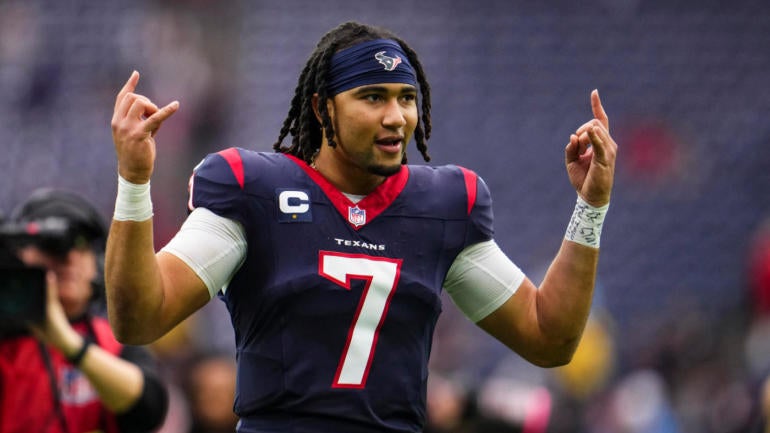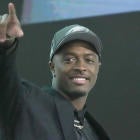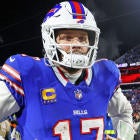
There's a reason that NFL teams are almost always seeking their next star quarterback in the draft. Having a player at the most important position in the league on a rookie-scale deal is a major advantage in team-building, as the extra space afforded by their relatively low salary affords a team the ability to add a ton of talent around him. The high-priced pieces come in free agency, of course, but the other building blocks for an offense often come via the draft.
With that in mind, we're going to take a look at what teams with rookie-scale quarterbacks did in the 2024 NFL Draft to help those players reach their respective ceilings. We'll break things down by class, working our way from the players selected in 2021 all the way up to this year's class. As you'll notice, the farther back we move in time, the fewer players still have starting roles. (The class of 2020 is headed into the fifth-year option season on their rookie contracts and Joe Burrow, Justin Herbert and Jalen Hurts have already gotten extended, while Tua Tagovailoa and Jordan Love probably will be soon.)
Without further ado ...
Class of 2021 (1)
Lawrence is the last man standing from a draft class that saw quarterbacks come off the board with each of the first three picks, as well as five in the first round. Zach Wilson, Trey Lance, Justin Fields and Mac Jones have all either lost their starting spot, been traded to a new team, or both.
The Jags had to come out of this draft with a receiver after seeing Calvin Ridley walk in free agency, and they did exactly that by landing LSU's Brian Thomas Jr. -- and doing so after a trade-down that allowed them to pick up some additional selections. Thomas has the luxury of not necessarily having to walk in and be the No. 1 guy right away given that the Jaguars still have Christian Kirk, Evan Engram and recently signed Gabe Davis, but he has that within the high end of his range of outcomes. He got overshadowed by Malik Nabers, but he had outrageous receiving numbers for the Tigers.
The Jaguars also added a running back on Day 3 in Keilan Robinson, which is an interesting move after how much they talked up Tank Bigsby last year, only to see him struggle badly on the field. Missouri offensive lineman Javon Foster was the only other offensive player Jacksonville took, but he's already 24 years old and Jacksonville has Brandon Scherff and Ezra Cleveland at guard, so it's hard to see him being more than a depth piece unless the Jaguars get hit with injuries.
Class of 2022 (1)
Purdy is also the last man standing from his draft class, which is ironic because, of course, he was also the last man standing in the actual draft. Kenny Pickett was the lone first-round quarterback in 2022, while Desmond Ridder has been replaced in Atlanta, neither Malik Willis nor Matt Corral ever ascended to the starting job and Sam Howell was traded from Washington to Seattle after the Commanders landed the No. 2 overall pick in this year's draft. (More on them later.)
Purdy was already surrounded by possibly the best group of skill-position players in the league, and Niners added to it by selecting both Ricky Pearsall and Jacob Cowing, which could signal that one of Deebo Samuel and Brandon Aiyuk is not long for San Francisco -- even if that doesn't come to pass ahead of the 2024 season. No. 3 wideout Jauan Jennings is also on a one-year deal and, if you're reading tea leaves, seems likely to move on after this year given that the Niners just drafted two receivers and will almost certainly be handing Purdy a huge contract extension next offseason.
Pearsall seems to have a lot of raw talent but he struggled to earn targets at Florida and is entering a very, very crowded pecking order. Meanwhile, Cowing lasting until pick 135 was somewhat surprising given his production at Arizona the last two seasons, but I suppose that's what happens when you're smaller and generally seen as a slot-only guy.
San Francisco has generally had a decent track record of identifying linemen in the mid-to-late rounds, even if they take a few years to ascend to the starting lineup. The Niners like to get ahead of those spots turning into glaring needs, and even if neither Dominick Puni nor Jarrett Kingston start right away, it wouldn't be surprising to see one of them become an important piece eventually.
And then San Francisco added yet another mid-round running back to its stable in Isaac Guerendo, which could signal an impending departure for guys like Elijah Mitchell, Jordan Mason and/or Tyrion Davis-Price. Unless Kyle Shanahan decides by midway through training camp that he just doesn't like Guerendo, which is of course possible, given his history of pounding the table for guys and quickly turning on them.
Class of 2023 (5-ish)
- Bryce Young, Panthers
- C.J. Stroud, Texans
- Anthony Richardson, Colts
- Will Levis, Titans
- Aidan O'Connell, Raiders
Young's rookie season was a disaster, and the Panthers clearly entered this offseason with an eye toward dramatically upgrading his supporting cast. They hired Dave Canales, who resurrected Baker Mayfield's career, as their new head coach. They splashed the pot for offensive linemen in free agency. They traded a draft pick for Diontae Johnson. And then they used first-, second-, and fourth-round picks on Xavier Legette, Jonathon Brooks and Ja'Tavion Sanders. The Legette pick is a bigger gamble than it might seem considering he had just 42 catches for 423 yards and five touchdowns in his first four seasons at South Carolina before breaking out as a COVID-year senior in 2023. That type of profile doesn't usually lend itself to strong NFL production. Brooks was mostly thought of as the top running back in this year's (very weak) running back class, but he's coming off a late-season torn ACL. And Sanders can be a field-stretcher up the seam but could also struggle to get on the field to begin with due to his deficiencies as a blocker.
Houston made its most significant addition by trading down out of the first round to add a second-round pick, then shipping that pick to the Bills for Stefon Diggs. The Texans used their other second on Blake Fisher, who will presumably start at right tackle. Tight end Cade Stover is already a better blocker than Dalton Schultz, and should therefore at least have a role as a rookie. He also caught way more passes than your typical Big Ten tight end, so there could be some upside there. Taking Jawhar Jordan late after trading for Joe Mixon and signing him to an extension could signal a possible exit for Dameon Pierce, who fell out of favor with the new coaching staff due to his poor scheme fit and was surpassed on the depth chart by Devin Singletary. And then interior lineman LaDarius Henderson is probably a depth piece.
For Indy, the most significant addition here is obviously Adonai Mitchell, who surprisingly fell to the back half of the second round. His production wasn't that great on a per-route basis and he seemingly had an unsustainably high touchdown rate this past season, but at 6-4 he has great size and he blazed through the 40 in 4.34 seconds. There's something to work with there, even if he doesn't develop into a true No. 1 guy. With Braden Smith missing at least six games in two of the last three seasons and not having much in the way of guaranteed money remaining on his contract beyond this year, and with Ryan Kelly entering his age-31 season and the final year of his contract, it wasn't surprising to see the Colts try to get out ahead of their potential departures by taking Matt Goncalves and Tanor Bortolini. They're unlikely to have major roles this year barring injury, but figure to factor heavily into Indy's future. It might be hard for Anthony Gould to crack the receiver depth chart given what's ahead of him (early-round picks Mitchell, Josh Downs and Alec Pierce, plus recently extended Michael Pittman Jr.).
Tennessee did almost all of its work in free agency, signing Lloyd Cushenberry, Tony Pollard and Calvin Ridley to build things up and get a real read on Will Levis before presumably making a decision on whether or not he is The Guy next year or the year after. But dropping JC Latham into the mix was important, as the Titans still had a massive need at tackle. With Bill Callahan coaching him up, it'd be surprising if Latham didn't hit his high-end outcome. Jha'Quan Jackson wasn't all that productive a receiver in five years at Tulane and is very, very small, but he fared pretty well as a return guy and that's probably his role here.
I debated whether or not to include O'Connell in this exercise given that the Raiders did give Gardner Minshew a decent-sized contract, but there's enough uncertainty about who will start that we might as well -- especially because the Raiders' draft was so interesting. Adding Brock Bowers to last year's second-round pick, Michael Mayer, is fascinating, and it will of course be interesting to track how each of them is deployed. Mayer is more of your traditional tight end and Bowers can basically operate as a big slot receiver, but it seems unlikely that either of them will get up into the 80%-90% snap range, which is generally what teams want their early-round picks to do. Jackson Powers-Johnson got some steam early in the draft process as a potential first-round pick at center, but will likely slot in at guard for Las Vegas, with only Thayer Munford (who really struggled in pass protection) in front of him. And by only adding sixth-round pick Dylan Laube to the backfield, the Raiders seemingly expressed a vote of confidence in running back Zamir White. Laube will turn 25 during his rookie season and only averaged 4.5 yards per carry as a senior at New Hampshire, though he did catch a ton of passes and could potentially contribute in that department.
Class of 2024 (6)
- Caleb Williams, Bears
- Jayden Daniels, Commanders
- Drake Maye, Patriots
- Michael Penix Jr., Falcons
- J.J. McCarthy, Vikings
- Bo Nix, Broncos
Like many other teams on this list, the Bears did a lot of their work in free agency and via trade, adding Keenan Allen, D'Andre Swift and Ryan Bates earlier this offseason. But after drafting Williams, they got the extremely good fortune of having Rome Odunze fall into their laps, and he should be both a contributor early on and eventually emerge as Williams' top target, given his prodigious skill. The Bears only had four picks in the draft, and used three of them on offense with Kiran Amegadjie being the other, and he should compete with Braxton Jones for the left tackle job.
Washington remade almost its entire offensive line this offseason, and also added Austin Ekeler to the backfield after letting Antonio Gibson walk. The Commanders continued giving Jayden Daniels pieces with their second- and third-round picks, and could potentially get three starters in tight end Ben Sinnott, tackle (or guard?) Brandon Coleman and receiver Luke McCaffrey (yes, Christian's brother and Ed's son).
New England has a long way to go to build around Maye. Signing Jacoby Brissett may be the most important thing the Pats did this offseason, as it could allow them to sit Maye this year and add more pieces next season before he has to take over. Still, it was important to land pass-catching help, and the Patriots took a bunch of shots at doing that with Ja'Lynn Polk and Javon Baker at receiver, Jaheim Bell at tight end, and probably Joe Milton III converting to tight end as well. Caedan Wallace has a chance to start right away at left tackle and Layden Robinson doesn't have much standing in his way of working up the depth chart at guard. There is still much more work to be done, but you have to start somewhere.
Apparently you shouldn't ask us about the Falcons' plans for Penix for another four or five years. So, we won't talk about them here.
Minnesota already had a strong ecosystem into which to drop a rookie quarterback, with Kevin O'Connell calling plays, Justin Jefferson and Jordan Addison at receiver, T.J. Hockenson at tight end, Aaron Jones and Ty Chandler in the backfield, and a pretty good offensive line. So, besides moving up one spot for McCarthy, the Vikes used most of their picks on defense and just added a couple depth pieces up front in Walter Rouse and Michael Jurgens. You don't typically expect sixth- or seventh-rounders to become starters, but maybe one of them hits.
Finally, the Broncos were working at a pick deficit thanks to the Russell Wilson trade, and only made one selection between when they picked Nix at No. 12 and his former college teammate, Franklin, in the fourth round. He had some Day 2 and even Day 1 buzz during the draft process, but obviously the NFL did not like him as much as the draft industrial complex. He is VERY skinny and didn't have a great combine, but he has obvious chemistry with the quarterback and that could lead to him having a decent-sized role. Audric Estimé could emerge as a significant contributor in the backfield, considering Javonte Williams didn't look all that great coming off his significant knee injury and Samaje Perine is getting up there in age. Despite Estimé's disappointing 40 time, there's a path to a real role here, with him perhaps playing the Mark Ingram to Jaleel McLaughlin's Alvin Kamara in Sean Payton's offense. Seventh-rounders Devaughn Vele and Nick Gargiulo will have to work their way up decently crowded depth charts, though Gargiulo likely has an easier path to playing time along the offensive line.
















